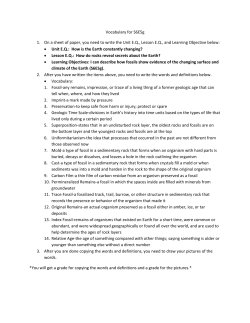
9. Sedimentary Rocks PPT
• Formed from weathered and eroded rock (sediments) that have been pressed and cemented together (lithification) • Most form under water • Rich in Fossils Sediments harden into sedimentary rock by lithification: • Deposition and Compaction - As layer after layer of sediments are deposited, the lower layers are pressed together tightly under the weight of the layers above. • Cementing - Some sediments are glued together by minerals dissolved in water • Classified by composition and the manner in which they formed 3 Categories: 1. Clastic 2. Chemical (Crystalline) 3. Organic (BioClastic) • Made from broken fragments of other rocks • Formed from a parent rock being weathered, eroded, compacted, and cemented (lithification) into a hard rock. • Conglomerate = rounded sediments • Breccia = angled sediments • Form when dissolved minerals come out of a solution (ex. Minerals collect when seas or lakes evaporate). • They are not made from pieces of pre-existing rocks (ex. Rock salt or Halite). • Made from the remains of once-living things. (ex. Fossil-rich limestone) • A rock made completely of shell fragments = coquina • Microscopic shell pieces = chalk • Pieces of dead plants buried under sediments = coal a) Sandstone is formed from grains of sand pressed tightly together. Sandstones are very common rocks. They are formed from the sand on beaches, in riverbeds, and sand dunes. Sandstones are usually made of the mineral quartz. b) Limestone is formed from tiny pieces of shells and of dead sea animals that have been cemented together. c) Conglomerate contains sand and rounded pebbles that have also been cemented together. d) Shale is formed from mud or clay that has been pressed together. Shale forms in quiet waters such as swamps and bogs. Sedimentary rocks can be easy to identify because you can actually see the layers.
© Copyright 2025










